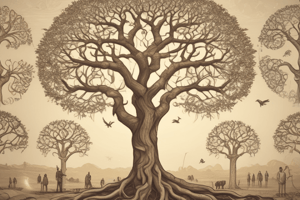Podcast
Questions and Answers
What is a phylogenetic tree used for?
What is a phylogenetic tree used for?
Represent evolutionary relationships
What is the name of a type of phylogenetic tree?
What is the name of a type of phylogenetic tree?
Cladogram
What is a clade?
What is a clade?
A group of all organisms with common traits
From whom did the idea of a phylogenetic tree come?
From whom did the idea of a phylogenetic tree come?
What does each line on a phylogenetic tree represent?
What does each line on a phylogenetic tree represent?
What does the distance between each line on a phylogenetic tree mean?
What does the distance between each line on a phylogenetic tree mean?
What does the line that connects all the branches represent on a phylogenetic tree?
What does the line that connects all the branches represent on a phylogenetic tree?
What can you see in a rooted phylogenetic tree?
What can you see in a rooted phylogenetic tree?
What is another name for the common ancestor in a phylogenetic tree?
What is another name for the common ancestor in a phylogenetic tree?
Does an unrooted phylogenetic tree show the common ancestor?
Does an unrooted phylogenetic tree show the common ancestor?
What is another term for clade?
What is another term for clade?
How do you know if you have a monophyletic group or not?
How do you know if you have a monophyletic group or not?
True or false: The information on patterns of evolutionary descent are the same regardless of the lengths of the branches in a phylogenetic tree?
True or false: The information on patterns of evolutionary descent are the same regardless of the lengths of the branches in a phylogenetic tree?
Flashcards
Phylogenetic Tree
Phylogenetic Tree
A diagram that shows the evolutionary relationships between different organisms.
Cladogram
Cladogram
A type of phylogenetic tree that shows the branching patterns of evolutionary relationships.
Clade
Clade
A group of organisms that share a common ancestor.
Common Ancestor
Common Ancestor
Signup and view all the flashcards
Line on a Phylogenetic Tree
Line on a Phylogenetic Tree
Signup and view all the flashcards
Distance between Lines
Distance between Lines
Signup and view all the flashcards
Connecting Line
Connecting Line
Signup and view all the flashcards
Rooted Phylogenetic Tree
Rooted Phylogenetic Tree
Signup and view all the flashcards
Outgroup
Outgroup
Signup and view all the flashcards
Unrooted Phylogenetic Tree
Unrooted Phylogenetic Tree
Signup and view all the flashcards
Monophyletic Group
Monophyletic Group
Signup and view all the flashcards
Monophyletic Group Feature
Monophyletic Group Feature
Signup and view all the flashcards
Branch Length on Phylogenetic Tree
Branch Length on Phylogenetic Tree
Signup and view all the flashcards
Study Notes
Phylogenetic Trees Overview
- Phylogenetic trees illustrate evolutionary relationships among different species.
- Cladogram is a specific type of phylogenetic tree used for branching diagrams.
Key Definitions
- A clade is a group consisting of all organisms that share common traits derived from a common ancestor.
- Charles Darwin introduced the concept of phylogenetic trees in evolutionary biology.
Structure and Interpretation
- Each line on a phylogenetic tree symbolizes an individual organism.
- The length of the lines indicates the estimated time since the last common ancestor shared by the organisms.
- The connecting line between branches symbolizes the common ancestor of the descendant groups.
Types of Phylogenetic Trees
- A rooted phylogenetic tree displays the outlying line connecting to the common ancestor.
- An outgroup refers to the common ancestor in a phylogenetic tree.
- Unrooted phylogenetic trees do not indicate the presence of a common ancestor.
Clades and Groups
- The term "monophyletic group" is synonymous with clade.
- A monophyletic group is identified when all descendants of a particular species are included.
Evolutionary Patterns
- The overall patterns of evolutionary descent remain consistent, regardless of branch lengths on the tree.
Studying That Suits You
Use AI to generate personalized quizzes and flashcards to suit your learning preferences.




